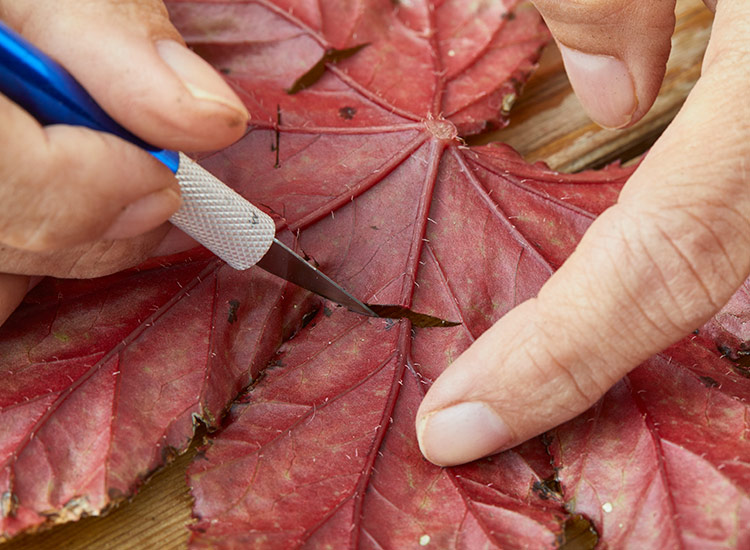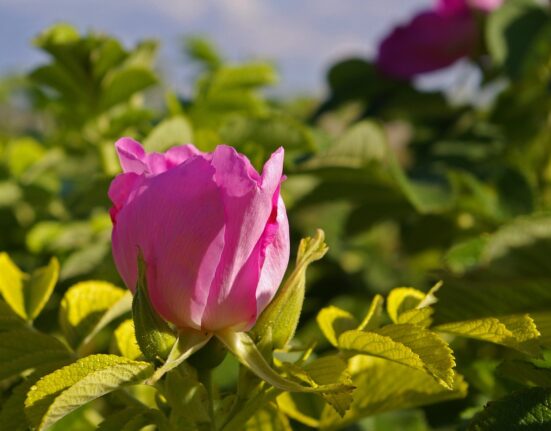Cutting is a plant’s detached vegetative part that, when separated and planted, can repair missing parts and develop into a new plant. It is a low-cost and fast method of propagation.
With only a few parent plants, a great number of uniform plants can be created. It does not necessitate the use of specialized expertise. The process is named for the plant part that is cut, such as the stem, root, or leaf.
This method is usually used in large scale commercial farming of rose plants.
It is mainly of four types by which gardeners decorate the plants through stem cutting such as Hardwood cutting, Semi-hardwood cutting, Softwood cutting, Herbaceous cutting.
Hardwood cutting-
Woody plants are used to make such a cutting. This approach is mostly used to propagate deciduous plants. Rose, grapes, fig, pomegranate, bougainvillea, tabernaemontana, lagerstroemia, Jasmine, hibiscus, and other plants are cut into acceptable size pieces and placed in the rooting media.


What is the procedure of the hardwood cutting method?
- Choose healthy, one-year-old branches with a pencil thickness. Make 10–15 cm long cuttings from the branches.
- Fruit tree rootstocks are grown from long cuttings. At least 4–5 latent vegetative buds must be present in each cutting. If there are any leaves or thorns, they are removed completely. This prevents the loss of moisture through transpiration.
- A slanting cut is made directly below the node at the base of the cuts, and a straight higher cut is made away from the top bud. The chopped piece will aid in the identification of the planting location. A slanting cut is made near the base of the cuttings, allowing a large area of the cuttings to come into contact with the rooting medium and induce root formation.
- Hormones secreted around the severed section of the bud cause roots. The use of wax to prevent transpiration loss minimizes the need for a straight cut at the top.
- For growing plants, the cuttings are slant-planted in a nursery bed or small poly bags. The cambium layer is made up of callus tissues, and this is where rooting takes place. The optimal time to plant cuttings is during the monsoon season for evergreens and November–February for deciduous species. For best results, plant cuttings in a greenhouse or poly-house.
Semi hardwood cutting-
A semi-hardwood cutting is taken from current season woody plant shoots that are 4 to 9 months old. Croton, acalephans, aralias, dieffenbachia, Roselia, cestrum, Nerium, and other beautiful foliage plants are propagated through semi-hardwood cuttings.


What is the procedure of semi hardwood cutting?
Semi-hardwood cuttings are made from branches that are about the thickness of a pencil. These cuttings range in length from 7.5 to 15 cm. At least 4–5 latent vegetative buds must be present on the cuttings. Some leaves are kept because they aid in the preparation of food through photosynthesis. Cutting reduces the size of large leaves.
A slant basal cut is made immediately near the vegetative bud, followed by a straight top cut away from the bud. The slant cut allows more of the cambium layer to be exposed, which aids in water absorption and callus production.
The higher straight cut lowers cuttings’ exposure to the atmosphere, resulting in less transpiration loss. To prevent infection and transpiration, soak the tops of the cuttings in wax. Early rooting is induced by dipping the base of the cuttings in IBA @ 5000 ppm before planting. The cuttings are planted with their maximal base in contact with the rooting medium by slanting them. Monsoon is the best time to plant semi-hardwood cuttings. Such cuttings are rooted commercially using a mist spray or fog.
Softwood cutting-


Herbaceous or succulent plants are used to make such a cutting. Softwood cuttings are made from the shoots of 2- to 3-month-old plants. Alternanthera, coleus, and clerodendrum are other examples.
What is the procedure of the softwood stem cutting method?
Softwood cuttings are made from mature, sensitive branches. These cuttings range in length from 10 to 12 cm. The food supply for tender shoots is insufficient. As a result, all leaves on the shoots are kept for photosynthesis. The cutting material is collected early in the morning and kept damp by being wrapped in a wet cloth. Softwood cuttings should be planted in sandy loam medium.
Herbaceous cutting-
Herbaceous plants are used to make such a cutting. Herbaceous cuttings are made from the shoots of plants that are 1 to 2 months old. Chrysanthemum, iresine, pilei, dahlia, petunia, carnation, marigold, and other flowers are examples.
What is the procedure of herbaceous cutting method?
Tender succulents, particularly the leafy section of herbaceous plant stems, are used to make herbaceous cuttings. A healthy shoot’s terminal, measuring 8–12 cm, is cut and the base leaves are removed, leaving the higher leaves undisturbed. Once detached, the cuttings must not dry out at the cut and must be rooted thoroughly under mist. The use of auxins aids in the regeneration of adventitious roots. Herbaceous cuttings should be planted in sandy loam medium.
The cutting method is also used in leaves as they are vegetative in some parts.
Leaf-cutting-
Leaf cutting is used to propagate plants with thick fleshy leaves and buds.
Vegetative buds can be found in leaf margin notches (bryophyllum) or on veins (begonia rex). Under favorable conditions, the leaf blade or parts of it with buds are placed on the rooting medium. The leaf blade, petiole, and a short section of the stem with attached axillary buds are kept in the medium for roots in the case of black raspberry. This method is used to propagate plants such as the snake plant (sansevieria), blackberry, rhododendron, and bryophyllum.


Cutting method has laid a great influence on modern gardening. Social developments, the expansion and spread of large cities with residential areas, and air connectivity allowing for plant exchanges all over the world all led to the mass production of ornamentals, necessitating the development of ever-improving plant multiplication technologies. Seeding, rhizomes and associated organs, layering, cuttings, and grafting are all basic plant propagation strategies that have been used from time immemorial.
During the historical period in question, changes and improvements to these basic procedures were largely technical advancements resulting from scientific advances in plant physiology, biochemistry, environmental impacts, and other fields, as well as their combination and interaction with plant material. Industrial progress, particularly the plastics industry, made a significant contribution to the advancement of plant propagation infrastructure, such as mist propagation. Tissue culture propagation is the only additional plant propagation technology produced at the time of this discussion.
Also Read– Try These DIY Projects to Refresh Your Apartment for Spring






